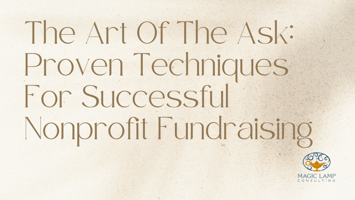At Magic Lamp Consulting, we pride ourselves in the work we do with nonprofits as consultants and...
Volunteer Engagement 101: Tips and Tricks for Nonprofits to Foster Lasting Connections

With restrained capacities and budgets, many times volunteer engagement stands as a cornerstone of nonprofit success, enabling organizations to extend their reach, amplify their impact, and strengthen community ties. The vitality of these engagements not only enriches the mission of the nonprofits but also fills volunteers with a sense of purpose and belonging. However, fostering these meaningful connections requires a thoughtful approach, blending strategy with sincerity. Together, the Magic Lamp Consulting team has created essential tips and tricks for nonprofits looking to cultivate long-lasting volunteer relationships.
Understanding Volunteer Motivations
To engage volunteers effectively, it’s crucial to first understand their motivations. People volunteer for a plethora of reasons: some seek to make a tangible difference in their communities, others are motivated by the desire to develop new skills, and still, others might be looking to forge new friendships. By identifying what drives your volunteers, you can tailor experiences that fulfill their expectations and, in turn, deepen their commitment to your cause.
Recruitment: Casting a Wide Net
Effective volunteer engagement begins with strategic recruitment. Cast a wide net by leveraging various platforms — social media, community bulletin boards, and volunteer matchmaking services — to share your opportunities. Craft your messages to resonate with the motivations you’ve identified, highlighting the impact of the work, the skills volunteers can gain, and the community they’ll be a part of. Remember, a personal touch can significantly enhance your outreach; consider reaching out directly to individuals who have shown interest in similar causes.
Onboarding: Laying the Foundation
A thorough and welcoming onboarding process is key to retaining volunteers. This is your opportunity to set expectations, introduce them to your organization's culture, and equip them with the necessary tools and knowledge. Make this experience as interactive and engaging as possible — think group activities, mentorship pairings, and hands-on training sessions. Ensuring that volunteers feel prepared and valued from the start fosters a sense of confidence and belonging.
Tailoring the Volunteer Experience
One size does not fit all when it comes to volunteer engagement. Tailor the volunteer experience by considering individual skills, interests, and availability. When volunteers feel that their unique contributions are recognized and valued, their engagement and satisfaction levels soar. Implement regular check-ins to gather feedback and adjust roles as needed, ensuring that each volunteer’s journey is both fulfilling and impactful.
Recognition and Appreciation
Never underestimate the power of recognition and appreciation. Simple gestures of gratitude can go a long way in making volunteers feel valued. Public acknowledgments, personalized thank-you notes, and volunteer appreciation events are just a few ways to celebrate their contributions. Additionally, providing certificates or letters of recommendation can offer tangible recognition of their hard work and dedication.
Building a Community
Fostering a sense of community among volunteers can significantly enhance engagement. Encourage connections through social events, online forums, and team-building activities. When volunteers feel part of a community, they are more likely to stay committed and spread the word about your cause. Sharing stories of how their work is making a difference can also strengthen their emotional connection to the mission.
Offering Growth Opportunities
Volunteers often look for opportunities to grow and develop new skills. Provide these opportunities by offering workshops, leadership roles, and cross-training in different areas of your organization. These experiences not only enrich the volunteer’s personal and professional life but also benefit your organization by cultivating a versatile and skilled volunteer base.
Maintaining Engagement Over Time
Sustaining volunteer engagement requires ongoing effort. Regular communication is key — keep volunteers informed about the organization's progress, upcoming events, and new opportunities. Surveys can be a valuable tool for gathering feedback and ideas for improvement. Additionally, creating a volunteer advisory board can give volunteers a voice in the organization and foster a deeper sense of ownership and commitment.
Nurturing Lasting Connections
Ultimately, the goal is to transform volunteers into lifelong advocates for your cause. This is achieved not just through the work they do, but through the relationships they build, the skills they acquire, and the recognition they receive. By investing in these areas, you create a volunteer experience that is both rewarding and impactful, encouraging volunteers to remain engaged over the long term.




